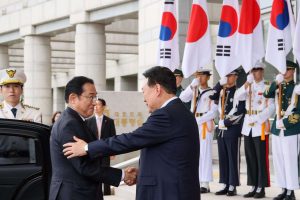The leaders of South Korea and Japan met in Seoul on Friday before Japanese Prime Minister Kishida Fumio leaves office. It was the 12th – and likely last – meeting between Kishida and President Yoon Suk-yeol while the two men are in office. The ruling Liberal Democratic Party in Japan will elect a new leader later this month, as Kishida has decided not to seek a second term.
According to South Korean Presidential Office, Yoon said the two countries should brace for unpredictable barriers that may arise against Japan-South Korea relations in the future.
“Developing South Korea-Japan relations is not a choice, but a historical responsibility,” Yoon said during a banquet with Kishida.
Kishida said the two countries are cooperating to deal with challenges of the international community as partners based on the trust and friendship between the leaders. He also thanked Yoon and his wife for the invitation to the banquet in Korean.
Compared with his predecessor Moon Jae-in’s tense relationship with the late Japanese Prime Minister Abe Shinzo years ago, Yoon has built a close relationship with Kishida by taking a pliable stance on the relationship.
Since he took office in May 2022, Yoon has tried to dial down tension with Tokyo, even though there were many ongoing contentious issues he had to deal with.
Before Yoon took office, the South Korean Supreme Court had ordered two Japanese companies, Mitsubishi Heavy Industries and Nippon Steel Corp, to provide more than more than 100 million won ($75,313) in compensation to Koreans who were forced to work for the Japanese military during Japan’s colonial rule on the Korean Peninsula. Japan flatly refused to provide compensation and instead hit South Korea with export controls that were widely viewed as retaliation for the court ruling.
Yoon tackled the issue via a contentious plan to compensate the forced labor victims through a fund fostered by the government-backed foundation. The plan, unveiled in March 2023, was widely denounced domestically but paved the way for Kishida and Yoon to exchange their first visits to each other’s countries.
Despite Yoon’s efforts to resolve historical disputes between the two countries, the victims of Japan’s colonial abuses – not only forced laborers but also the “comfort women” – have not ceased their demands toward Tokyo for fresh apologies. However, the Kishida government has not ignored such requests and pointed to the 1965 agreement that normalized relations between the two countries. Japan’s position is that the 1965 treaty finally resolved the issue of compensation, implying there are no ongoing historical disputes.
When Japan announced its plan to release contaminated wastewater from the damaged Fukushima nuclear power plant, South Koreans expressed worries over the environmental consequences. Despite public concern, the Yoon government said there would be no problem if Japan released the water “in a transparent manner based on science.”
However, South Korean analysts continue to question whether Japan released all the necessary information to keep an eye on its release process. There is widespread skepticism over Japan’s claim that the contaminated water can be released safely.
Although Yoon and Kishida have reiterated the importance of strengthening cooperation to deal with challenges posed by North Korea and China, Tokyo has never withdrawn its stance on the Dokdo Islands, which Japan calls Takeshima and claims are a part of its territory. This is one area where the Yoon government has stood firm. Despite its friendly and dovish stance toward Japan, the Yoon government criticized Tokyo’s claims over the Dokdo Islands whenever they appeared. However, Japan continues to advance its position; it stipulated the islets as its own in its 2024 Diplomatic Bluebook. To many South Koreans, Japan’s continued claim over the territory is a sign that Tokyo has no intention to repay Yoon’s efforts to rebuild relations with Japan.
Lastly, the designation of Japan’s Sado Island gold mines as a UNESCO World Heritage Site in late July brought more criticism from South Koreans over the Yoon government’s decision to approve the listing. According to media reports, Seoul’s condition for the agreement was that Japan explain the whole history of the site, which was a notorious forced labor site during the 1930s and ‘40s.
Japan installed an exhibition hall to commemorate the Korean workers at the Aikawa History Museum near the mine. However, the problem is the exhibition hall is located 2 kilometers away from the Sado Mine main site, meaning those who visit the site may not visit the exhibition hall. Even though the Yoon government touted the exhibition hall commemorating the Korean workers as an outcome of its negotiations with Japan, many experts and academics saw the UNESCO episode as another example of Seoul making repeated concessions to Japan with little offered in return.
Looking back at the 18 months between Yoon’s visit to Tokyo and Kishida’s final trip to Seoul, it is questionable what South Korea has gained by shifting its approach to Japan. Tokyo has not made fresh (and direct) apologies for the historical disputes and continues to claim Dokdo as its own. Japan successfully listed the Sado gold mine as a UNESCO World Heritage Site and implemented its plan to release the Fukushima contaminated water.
Whoever Kishida’s successor is, Japan’s next prime minister will enjoy a favorable position on South Korea issues thanks to Kishida’s legacy and Yoon’s one-sided compromises toward Tokyo.
































